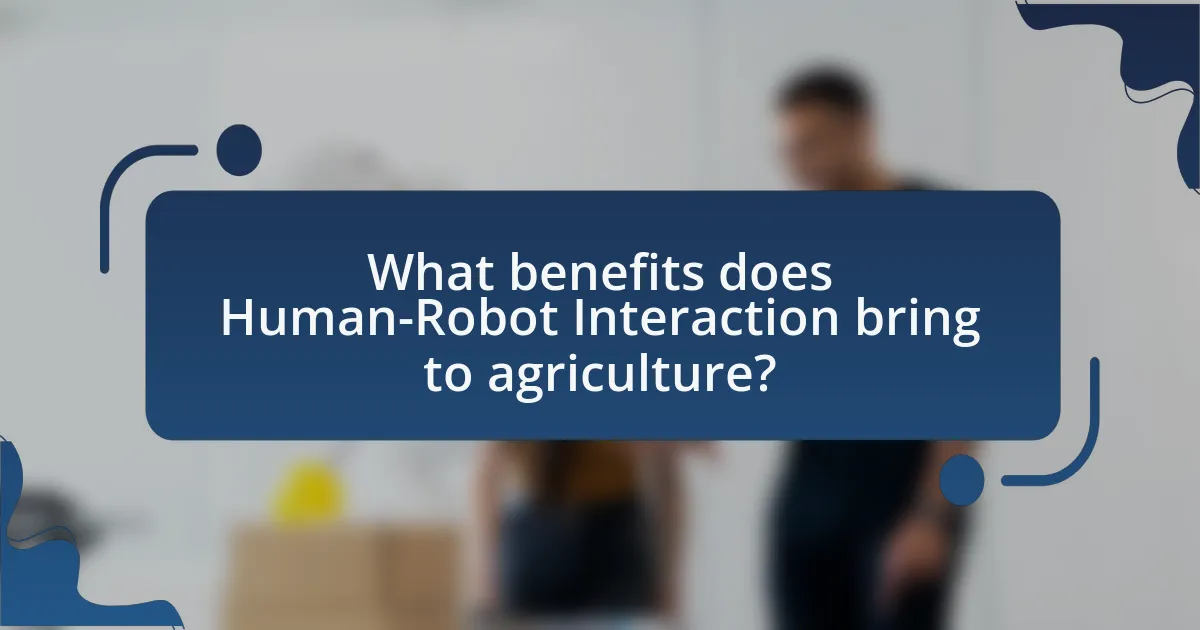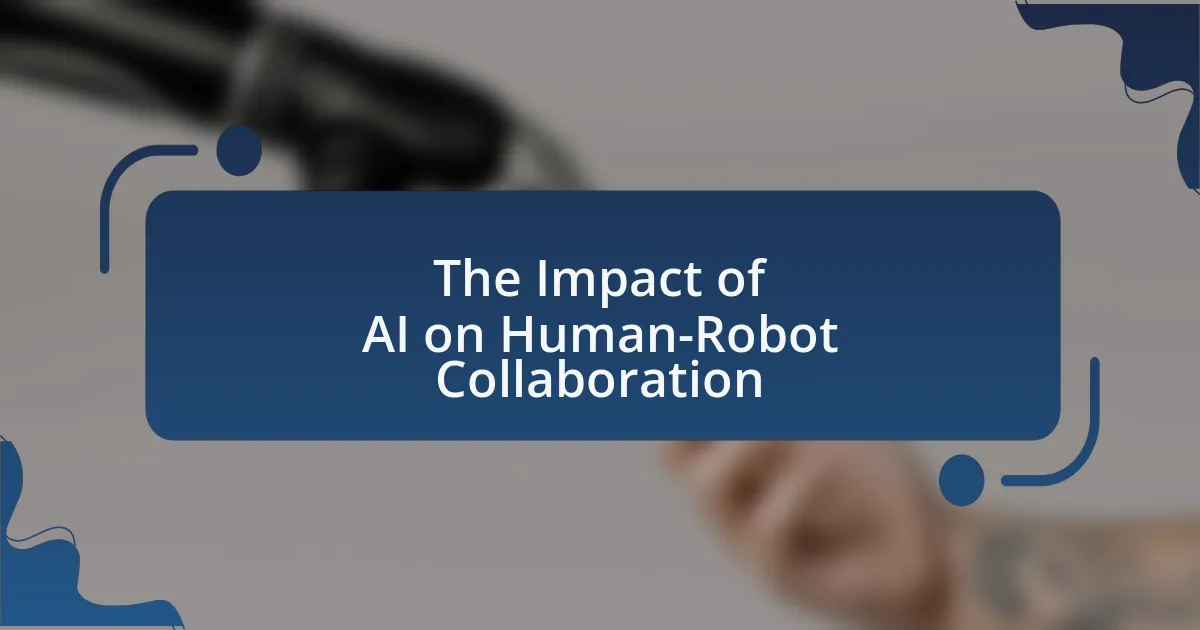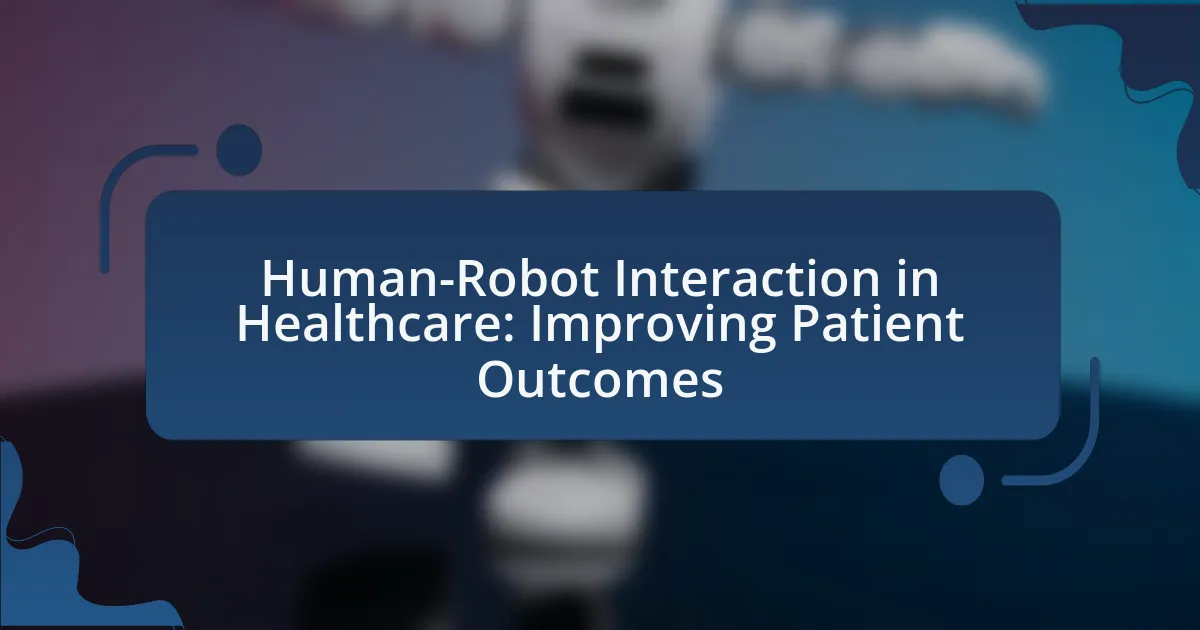Human-Robot Interaction in Agriculture refers to the collaborative engagement between humans and robotic systems in farming, enhancing productivity through tasks such as planting, harvesting, and crop monitoring. This integration leads to increased efficiency, reduced labor costs, and improved crop yields, with studies indicating potential yield increases of up to 30%. Various types of robots, including autonomous tractors and drones, are utilized to optimize farming practices, while advancements in artificial intelligence and machine learning facilitate seamless communication between robots and farmers. Despite challenges such as high costs and technological limitations, the positive perception among farmers highlights the potential for robots to transform agricultural operations and promote sustainable practices.

What is Human-Robot Interaction in Agriculture?
Human-Robot Interaction in Agriculture refers to the collaborative engagement between humans and robotic systems in farming environments. This interaction enhances agricultural productivity by enabling robots to perform tasks such as planting, harvesting, and monitoring crops, while humans provide oversight and decision-making. Research indicates that the integration of robots can lead to increased efficiency and reduced labor costs, with studies showing that robotic systems can improve crop yields by up to 30% through precision farming techniques.
How does Human-Robot Interaction enhance farming practices?
Human-Robot Interaction enhances farming practices by improving efficiency, precision, and productivity in agricultural tasks. Robots equipped with advanced sensors and AI can perform tasks such as planting, harvesting, and monitoring crop health with greater accuracy than human laborers. For instance, a study by the International Journal of Agricultural and Biological Engineering found that autonomous tractors can reduce fuel consumption by up to 30% while increasing crop yield through optimized planting patterns. Additionally, robots can operate in challenging conditions, allowing for continuous farming operations regardless of weather, which further boosts overall productivity.
What types of robots are used in agriculture?
Various types of robots are used in agriculture, including autonomous tractors, drones, robotic harvesters, and weeding robots. Autonomous tractors perform tasks such as plowing and planting with minimal human intervention, enhancing efficiency. Drones are utilized for crop monitoring and precision agriculture, providing aerial imagery and data analysis to optimize yields. Robotic harvesters automate the picking process, significantly reducing labor costs and increasing productivity. Weeding robots identify and remove weeds with precision, minimizing the need for chemical herbicides. These technologies collectively contribute to transforming farming practices by improving efficiency, reducing labor costs, and promoting sustainable agriculture.
How do these robots interact with human farmers?
Robots interact with human farmers primarily through collaborative tasks, communication, and data sharing. These robots are designed to assist in various agricultural activities such as planting, harvesting, and monitoring crop health, thereby enhancing productivity. For instance, autonomous tractors can work alongside farmers by following their commands and adapting to their workflows, which allows for efficient land use and reduced labor costs. Additionally, robots equipped with sensors can provide real-time data on soil conditions and crop status, enabling farmers to make informed decisions. This interaction is supported by advancements in artificial intelligence and machine learning, which facilitate seamless communication between robots and farmers, ultimately transforming traditional farming practices into more efficient and data-driven operations.
What are the key technologies driving Human-Robot Interaction in agriculture?
Key technologies driving Human-Robot Interaction in agriculture include artificial intelligence, machine learning, computer vision, and sensor technologies. Artificial intelligence enables robots to make decisions based on data analysis, while machine learning allows them to improve their performance over time through experience. Computer vision facilitates the identification and classification of crops and pests, enhancing precision in farming tasks. Sensor technologies, such as GPS and LiDAR, provide real-time data on soil conditions and crop health, enabling robots to operate efficiently and effectively. These technologies collectively enhance the collaboration between humans and robots, leading to improved agricultural productivity and sustainability.
How does artificial intelligence contribute to this interaction?
Artificial intelligence enhances human-robot interaction in agriculture by enabling robots to understand and respond to human commands and environmental conditions. AI algorithms process data from sensors and cameras, allowing robots to perform tasks such as planting, harvesting, and monitoring crop health with precision. For instance, AI-driven systems can analyze soil conditions and weather patterns to optimize planting schedules, thereby increasing yield and efficiency. Research indicates that farms utilizing AI technologies can achieve up to a 30% increase in productivity, demonstrating the significant impact of AI on agricultural practices.
What role does machine learning play in agricultural robotics?
Machine learning plays a crucial role in agricultural robotics by enabling robots to analyze data and make decisions autonomously. This technology allows agricultural robots to optimize tasks such as planting, harvesting, and monitoring crop health through real-time data analysis. For instance, machine learning algorithms can process images from drones or ground-based sensors to identify plant diseases or nutrient deficiencies, leading to timely interventions. Studies have shown that the integration of machine learning in agricultural robotics can increase crop yields by up to 20% while reducing resource usage, demonstrating its effectiveness in transforming farming practices.
What challenges are faced in implementing Human-Robot Interaction in agriculture?
Implementing Human-Robot Interaction in agriculture faces several challenges, including technological limitations, high costs, and the need for effective communication between humans and robots. Technological limitations arise from the complexity of agricultural environments, which can hinder robot navigation and task execution. High costs associated with developing and maintaining robotic systems can deter farmers from adopting these technologies. Additionally, effective communication is crucial; robots must interpret human commands accurately and respond appropriately, which requires advanced artificial intelligence and machine learning capabilities. These challenges must be addressed to facilitate the successful integration of robots into agricultural practices.
What are the common technical barriers to adoption?
Common technical barriers to adoption in human-robot interaction in agriculture include high costs, lack of interoperability, insufficient infrastructure, and limited technical expertise. High costs deter farmers from investing in robotic systems, as initial investments can be substantial. Lack of interoperability among different robotic systems and agricultural machinery complicates integration, making it difficult for farmers to adopt new technologies. Insufficient infrastructure, such as inadequate internet connectivity in rural areas, hampers the effective deployment of advanced robotic solutions. Limited technical expertise among farmers and agricultural workers further restricts the ability to operate and maintain these technologies, leading to underutilization. These barriers collectively hinder the widespread adoption of robotic systems in agricultural practices.
How do farmers perceive the integration of robots in their practices?
Farmers generally perceive the integration of robots in their practices positively, viewing them as tools that enhance efficiency and productivity. A survey conducted by the American Farm Bureau Federation in 2021 indicated that 70% of farmers believe robotics can significantly improve their operations by reducing labor costs and increasing precision in tasks such as planting and harvesting. Additionally, farmers appreciate the potential for robots to alleviate labor shortages, which have become a pressing issue in agriculture. This positive perception is supported by advancements in technology that demonstrate robots’ capabilities in performing repetitive tasks, thereby allowing farmers to focus on more strategic aspects of their operations.

What benefits does Human-Robot Interaction bring to agriculture?
Human-Robot Interaction (HRI) brings significant benefits to agriculture by enhancing efficiency, precision, and safety in farming practices. HRI enables robots to perform tasks such as planting, harvesting, and monitoring crops with high accuracy, which reduces labor costs and increases productivity. For instance, autonomous tractors equipped with advanced sensors can optimize field operations, leading to a reported 20-30% increase in yield due to precise resource application. Additionally, robots can operate in hazardous conditions, minimizing the risk to human workers. Studies have shown that integrating HRI in agriculture can lead to a 50% reduction in pesticide usage through targeted application, promoting sustainable farming practices.
How does it improve efficiency in farming operations?
Human-robot interaction improves efficiency in farming operations by automating repetitive tasks, thereby reducing labor costs and increasing productivity. For instance, autonomous tractors and drones can perform planting, monitoring, and harvesting with precision, which minimizes resource waste and enhances crop yields. Research indicates that farms utilizing robotic systems can achieve up to a 30% increase in operational efficiency due to faster task completion and optimized resource management.
What specific tasks can robots perform to save time and resources?
Robots can perform specific tasks such as planting, harvesting, and monitoring crops to save time and resources in agriculture. For instance, autonomous planting robots can plant seeds at optimal depths and spacing, significantly reducing labor costs and time compared to manual planting. Harvesting robots can efficiently pick ripe fruits and vegetables, minimizing waste and ensuring that crops are harvested at their peak quality. Additionally, monitoring robots equipped with sensors can assess soil health and crop conditions in real-time, allowing farmers to make informed decisions that optimize resource use, such as water and fertilizers. These tasks collectively enhance productivity and sustainability in farming practices.
How does automation affect crop yield and quality?
Automation significantly enhances crop yield and quality by optimizing farming practices through precision and efficiency. Automated systems, such as drones and robotic harvesters, enable precise planting, monitoring, and harvesting, which reduces waste and increases productivity. For instance, a study published in the journal “Agricultural Systems” found that farms utilizing automated irrigation systems experienced a yield increase of up to 30% due to improved water management. Additionally, automation minimizes human error and labor costs, allowing for more consistent crop quality. Research from the “Journal of Precision Agriculture” indicates that automated pest and nutrient management can lead to healthier crops, further improving overall yield and quality.
What economic advantages does Human-Robot Interaction offer to farmers?
Human-Robot Interaction offers significant economic advantages to farmers by enhancing productivity and reducing labor costs. The integration of robots in agriculture allows for precise tasks such as planting, harvesting, and monitoring crops, which can lead to increased yields. For instance, a study by the International Journal of Agricultural and Biological Engineering found that robotic systems can improve efficiency by up to 30%, thereby maximizing output per acre. Additionally, the use of robots minimizes the need for manual labor, which can be costly and difficult to source, especially during peak seasons. This reduction in labor costs, combined with increased efficiency, results in higher profit margins for farmers.
How can robots reduce labor costs in agriculture?
Robots can reduce labor costs in agriculture by automating repetitive tasks such as planting, harvesting, and weeding. Automation minimizes the need for manual labor, which is often expensive and subject to shortages. For instance, a study by the International Journal of Agricultural and Biological Engineering found that the use of robotic harvesters can decrease labor costs by up to 30% while increasing efficiency and yield. Additionally, robots can operate continuously without breaks, further enhancing productivity and reducing overall labor expenses in farming operations.
What is the return on investment for farmers using robotic systems?
The return on investment for farmers using robotic systems can be significant, often ranging from 20% to 50% depending on the type of technology and its application. For instance, a study by the American Society of Agricultural and Biological Engineers found that farmers who adopted robotic milking systems reported increased milk production and reduced labor costs, leading to a return on investment of approximately 30% within the first three years. Additionally, robotic systems for crop monitoring and harvesting have shown to enhance efficiency and reduce waste, further contributing to profitability.
How does Human-Robot Interaction contribute to sustainable farming practices?
Human-Robot Interaction (HRI) enhances sustainable farming practices by optimizing resource use and improving crop management. Through the integration of robots equipped with advanced sensors and AI, farmers can monitor soil health, water usage, and crop conditions in real-time, leading to more precise application of water, fertilizers, and pesticides. For instance, a study by the University of Illinois demonstrated that robotic systems could reduce water usage by up to 30% while maintaining crop yields, showcasing the efficiency gains from HRI. Additionally, robots can perform tasks such as planting, weeding, and harvesting with minimal soil disturbance, which helps preserve soil integrity and biodiversity. This synergy between human oversight and robotic efficiency ultimately supports sustainable agricultural practices by reducing waste and enhancing productivity.
What role do robots play in precision agriculture?
Robots play a crucial role in precision agriculture by enhancing efficiency and accuracy in farming practices. They are utilized for tasks such as planting, monitoring crop health, and harvesting, which allows for data-driven decision-making. For instance, autonomous drones equipped with sensors can assess crop conditions and provide real-time data on soil moisture and nutrient levels, leading to optimized resource use. Research indicates that the integration of robotic systems can increase crop yields by up to 20% while reducing labor costs significantly, demonstrating their effectiveness in modern agricultural practices.
How can robots help in reducing chemical usage in farming?
Robots can help reduce chemical usage in farming by enabling precision agriculture techniques that target specific areas for treatment rather than applying chemicals uniformly across entire fields. For instance, autonomous drones equipped with sensors can identify pest infestations or nutrient deficiencies in crops, allowing farmers to apply pesticides or fertilizers only where needed. Research from the University of California, Davis, indicates that precision application can reduce chemical use by up to 30%, minimizing environmental impact and lowering costs for farmers. Additionally, robots can utilize advanced algorithms and machine learning to analyze data from various sources, further optimizing chemical application and ensuring that only the necessary amounts are used.

What are the future trends in Human-Robot Interaction in agriculture?
Future trends in Human-Robot Interaction in agriculture include increased collaboration between humans and robots, enhanced autonomy of agricultural robots, and the integration of artificial intelligence for improved decision-making. As agricultural practices evolve, robots are expected to work alongside farmers, assisting in tasks such as planting, harvesting, and monitoring crop health. Research indicates that the use of AI-driven robots can lead to more efficient resource management and higher crop yields, as evidenced by studies showing that precision agriculture techniques can increase productivity by up to 20%. Additionally, advancements in sensor technology and machine learning will enable robots to adapt to changing environmental conditions, further optimizing agricultural operations.
How is the technology expected to evolve in the coming years?
Technology in human-robot interaction for agriculture is expected to evolve significantly in the coming years through advancements in artificial intelligence, machine learning, and robotics. These advancements will enable robots to perform more complex tasks autonomously, such as planting, harvesting, and monitoring crop health with greater precision. For instance, the integration of AI-driven analytics will allow robots to analyze soil conditions and weather patterns in real-time, optimizing farming practices and increasing yield efficiency. Additionally, the development of collaborative robots, or cobots, will enhance the synergy between human workers and machines, leading to safer and more productive farming environments. According to a report by the International Federation of Robotics, the agricultural robotics market is projected to grow at a compound annual growth rate of 20% from 2021 to 2026, indicating a robust trend towards increased automation and efficiency in agricultural practices.
What advancements in robotics are anticipated to impact agriculture?
Advancements in robotics anticipated to impact agriculture include autonomous tractors, drones for crop monitoring, and robotic harvesters. Autonomous tractors can perform tasks such as plowing and planting with minimal human intervention, increasing efficiency and reducing labor costs. Drones equipped with sensors provide real-time data on crop health, enabling precision agriculture practices that optimize resource use. Robotic harvesters are designed to pick fruits and vegetables, addressing labor shortages and improving harvest efficiency. These technologies are supported by research indicating that automation can enhance productivity and sustainability in farming practices.
How might farmer-robot collaboration change in the future?
Farmer-robot collaboration is likely to evolve towards increased autonomy and integration of advanced technologies. As artificial intelligence and machine learning improve, robots will be able to perform complex tasks such as precision planting, pest detection, and crop monitoring with minimal human intervention. For instance, a study by the International Journal of Agricultural Robotics indicates that autonomous robots can enhance efficiency by up to 30% in crop management. This shift will enable farmers to focus on strategic decision-making while robots handle routine operations, ultimately transforming agricultural practices and productivity.
What are the implications of Human-Robot Interaction for the agricultural workforce?
Human-Robot Interaction (HRI) significantly impacts the agricultural workforce by enhancing productivity and efficiency while also posing challenges related to job displacement. The integration of robots in agriculture allows for tasks such as planting, harvesting, and monitoring crops to be performed with greater precision and speed, leading to increased yields. For instance, a study by the International Journal of Agricultural and Biological Engineering found that autonomous tractors can improve field efficiency by up to 30%. However, this technological advancement raises concerns about the potential reduction in labor demand, as robots may replace manual laborers in various farming tasks. The shift towards automation necessitates workforce retraining and adaptation to new roles that focus on managing and maintaining robotic systems.
How will job roles in agriculture change with increased automation?
Job roles in agriculture will increasingly shift from manual labor to technology management and oversight due to automation. As machines and robotics take over tasks such as planting, harvesting, and monitoring crops, the demand for skilled workers who can operate, maintain, and troubleshoot these technologies will rise. For instance, a report by the World Economic Forum indicates that automation could displace 75 million jobs globally by 2022, while creating 133 million new roles that require advanced technical skills. This transition emphasizes the need for agricultural workers to adapt by acquiring new competencies in data analysis, machine operation, and system management, thereby transforming the workforce landscape in agriculture.
What skills will future farmers need to work alongside robots?
Future farmers will need skills in technology management, data analysis, and robotics operation to work alongside robots. As agriculture increasingly integrates automation, farmers must understand how to operate and maintain robotic systems, which includes familiarity with programming and troubleshooting. Additionally, data analysis skills are essential for interpreting information collected by robots, such as soil health and crop yields, enabling informed decision-making. According to a report by the Food and Agriculture Organization, the adoption of precision agriculture technologies is expected to grow, highlighting the necessity for farmers to adapt to these advancements.
What practical tips can farmers consider when integrating robots into their practices?
Farmers should start by assessing their specific needs and identifying tasks that robots can effectively perform, such as planting, harvesting, or monitoring crops. This targeted approach ensures that the integration of robots enhances productivity and efficiency. For instance, a study by the International Journal of Agricultural and Biological Engineering highlights that robots can increase crop yield by up to 30% when used for precision agriculture tasks. Additionally, farmers should invest in training programs for their staff to ensure they are equipped to work alongside robots, as effective human-robot collaboration is crucial for maximizing the benefits of automation. Furthermore, farmers should consider the scalability of robotic solutions, ensuring that the technology can adapt to changing farm sizes and practices over time.





